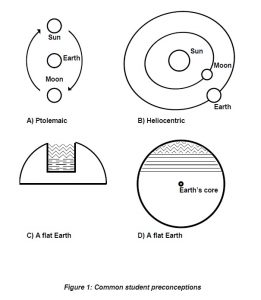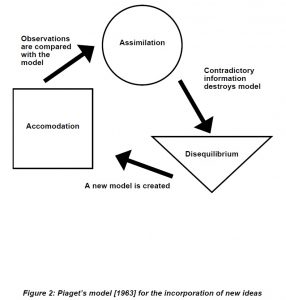John E. DeLaughter (Dept. of Geological Sciences, Northwestern University, Evanston, IL)
Seth Stein (Dept. of Geological Sciences, Northwestern University, Evanston, IL)
Carol Stein (Dept. of Earth and Environmental Sciences, University of Illinois at Chicago, Chicago, IL)
Kenneth R. Bain (Searle Center for Teaching Excellence, Northwestern University, Evanston, IL)
This site contains data relating to a paper published in the August 25, 1998, issue of Eos.
Abstract
Assessment of the success of any educational technology requires analysis of what students know bother before and after a course. Studies have shown that many students enter introductory physics courses with misconceptions which are often unchanged reguardless of teaching method. To see whether such misconceptions are commonly held by introductory geology students, we gave an “earth science literacy” test to 149 students at the University of Illinois at Chicago taking an introductory geology course.
Earth Science Literacy Test
The test population
Total: 149 |
Science majors were predominantly in psychology and anthropology; no geology majors were in this group. |
|
Typical college math classes included pre-algebra and introductory calculus. |
|
|
The results of the test
Summary:
- Most students described Earth as a layered planet; however, many believed that there exists a magma layer within Earth.
- Most students stated that earthquakes reflect the movement of subterranean plates. Most believe that volcanism derives from excess heat and/or pressure, often within Earth’s core. Both processes were frequently associated with warmer climates and the ocean.
- Many students attribute the Mid-Atlantic Ridge to a rise in water levels. Few gave seafloor spreading as a cause; many believe it is due to a collision of two plates.
- Equal numbers of students put the extinction of the dinosaurs before 1 Ma and between 10 and 90 Ma. Many students placed the beginning of at a few Ga, but a significant number placed it before 1 Ma. Though most gave the age of Earth as a few Ga, 23% of the responses to all three questions included a logical contradiction (e.g., the dinosaurs becoming extinct before life arose).
- Most students believe global warming is due to destruction of the ozone layer; few cited increased CO2.
- More than half of the students believe that salt melts ice by a chemical reaction.
- As in the famed Harvard study, most students attributed the seasons to the distance of Earth from the Sun.
This test will be refined to better understand students’ geological preconceptions and to evaluate the effectiveness of teaching methods.
Related Links
The Eos article
Our geophysics concepts demonstration page
This site was selected as the Virtual Geoscience Professor’s Site of the Fortnight for October 5, 1998.


